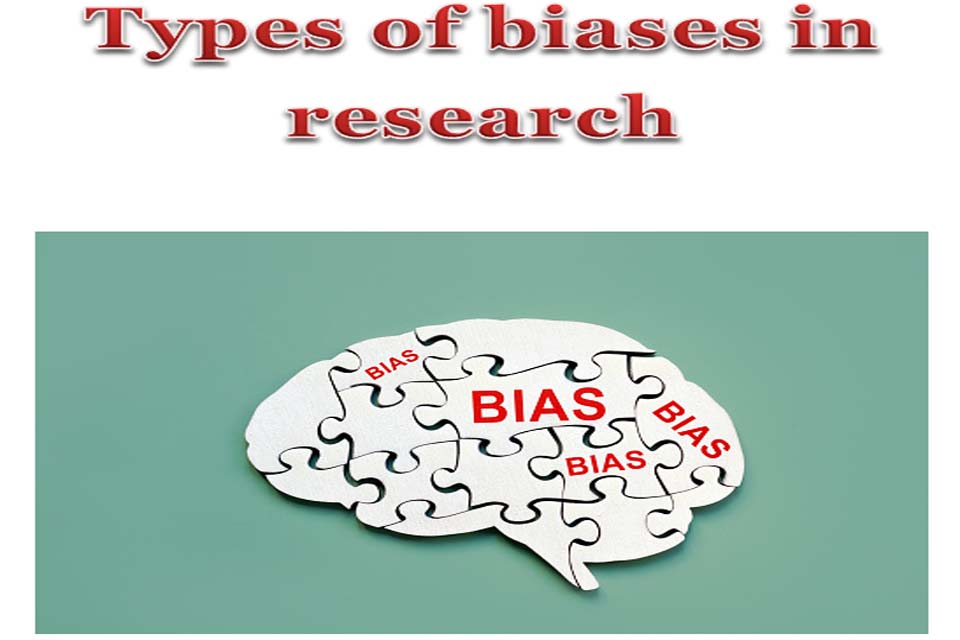Discovering the types of biases in research and measures to reduce it

Question: What is a research bias? What are the types of biases in research? State the measures that can be adopted to reduce biases.
Writing a research paper can be tough for all students as it involves exploring huge amounts of data, collecting, analyzing, and interpreting them accurately.If a student is looking to generate a particular research outcome, all data and measures must be correct and adhere to the paper’s topic and objectives.At this point, research bias emerges. In this blog on the types of biases in research, we will try to explain bias in research, its types, and its mitigation factors.
Research bias: An overview
Bias in research occurs with any departure from truth, leading to misrepresented results and incorrect conclusions.Bias can occur at any stage of your research process, such as duringdata collection, analysis, and interpretation.Both quantitative and qualitative research can face problems based on bias.Research biascan occur due to intentional manipulation by the researcher to direct the research process to generate results as per their preference, orthey can omit some samples, generating inaccurate outcomes and conclusions.
The other factors that can lead to bias are errors in collecting data, analyzing them, publication bias, conflict of interest, etc.It is crucial to understand the research bias due to the following reasons mentioned in this blog on types of biases in research:
• All researches have bias, covering research design, which is challenging to remove.
• At any phase of the research process, bias can take place.
• The validity and reliability of the findings can be impacted by distorting data.
It is quite impossible to carry out a study without some inch of research bias.Let’s explain bias in research with the aid of an example:
Assume that you are researching to find out whether or not a specific weight loss program is successful among diabetes people. The research may be biased if you concentrate on whether members finish the program.
For instance, the program’s completion rate will likely be influenced if members begin to leave it.Members disappointed in not reducing weight may leave the program, whereas those who see a reduction will continue with it. Consequently, it may lead to a more favorable outcome, which is a bias.
To give an unbiased finding, the difference between the members who continue with the program and those who leave is vital to consider eliminating bias.
Anyways, conducting research for a research task requires total attention and a concentrated attitude. If you find it a challenging task, you can take help from our research paper writing services to avail professional help in writing a trustworthy research paper.
Types of biases in research
As a matter of course, research bias can be divided into two broad categories: conscious and unconscious biases.Let’s understand these two types of biases in research along with other types in this blog section on types of biases in research.
Conscious bias:Conscious research bias is about the personal preference and intentions of the researcher in the study. They impact the result of the study by intentionally favoring a particular outcome. It can also occur from personal agendas, conflicts of interest, keenness to acquire desired results, or external pressure. For instance, a religious researcher will go by a specific belief when systematically investigating topics based on religion.
Unconscious: Unconscious bias is a significant part of bias. It usually happens when the researcher unknowingly clasps bias, which can affect the research process at every stage. These biases can be in the form of social influences, serotypes, or cultural norms. When informed about these biases and the influencing factors, one can actively work to remove them to generate accurate and uninfluenced research results.
Being a researcher, you should manage both kinds of biases at the time of and during conducting the qualitative and quantitative research.To get proper knowledge about biases, you must employ meticulous research practices, use correct data samples, self-reflection, and apply measurable objectives and analysis techniques.Keeping a note of bias and its consequences, you can lessen its impact and increase the credibility of the research outcome.
Now let’s move on to understanding the types of biases in research in the following parts.
Respondent bias: The inclination for surveying respondents to give answers that are inaccurate to an extent is known as respondent bias. It often happens due to social desirability bias or a wish to delight a researcher. To reduce the effect of respondent bias, anonymous surveys or questions having careful words can be of great help.
Acquiescence bias: It takes place when research participants accept inappropriate survey questions, irrespective of their beliefs and experiences. It can result in incorrect research outcomes and distorted data. To lessen the effect of this bias, a researcher can think about using mixed-format questions, or reverse-coded questions, comprising both positively and negatively expressed questions.In addition, a researcher can pay stress the significance of giving truthful and honest responses to survey participants to minimize the probability of this bias.
Social desirability bias:The bias occurs when research participants address research questions in the form of a survey to make the viewers believe that the responses are favorable; instead of giving honest responses.Consequently, it can also give rise to systematic errors in research findings.The effect of these types of biases in research can be minimized by giving honest responses and using indirect questioning.Along with this, the researcher can also mix methods in the data collection process, like interviews and observations, to correctly represent the behavior and attitude of the participants.
Sponsor bias: The bias occurs when the research is financed by an institution or individual with an absolute interest in the research outcome. To reduce the effect of these types of biases in research, a researcher can announce the funding sources, use independent data analysis, and include many stakeholders in the research process. The researcher can also conduct sensitivity analysis to evaluate the effect of probable sponsor bias on their findings.
Habituation: The bias occurs when a research’s participants become familiar with the survey questions, which may give rise to biased responses. To reduce the impact of these types of biases in research, a researcher should think about different question formats and order, steer clear of leading questions, and use randomized response techniques. They can also use many ways of gathering data to ensure participants are not becoming too clear about the survey questions.
Researcher bias:The bias concerns the researcher’s opinions or personal bias impacting the study’s outcome. The quantitative research bias occurs when choosing personal or sensitive topics for a research paper. To minimize its impact, the researcher must select research participants to carry out the research, engage blind or double-blind study designs, and utilize objective measures to gather and evaluate data.Contact our writers if you want more details about bias and how to avoid it.They have mastered writing research papers on different topics and can provide extensive knowledge on avoiding biases.
Confirmation bias:In this bias, the researcher asks for information validating their previous beliefs while setting aside the information that refutes them. It can make way for inaccurate or incomplete views. To minimize these types of biases in research, it is vital to ask for various viewpoints and information sources to handle data impartially, considering all probabilities.
Cultural bias: In this bias, the researcher evaluates individuals, behaviors, events, etc., based on cultural standards. It can result in stereotypes, misunderstanding, and inequitable treatment of people from varied cultures.To reduce these types of biases in research, it is essential to know one’s cultural standards and biases and to interact with people from across cultures impartially and keenness to learn.
Question-order bias occurs when the arrangement of the order of interview or survey questions impacts the participant’s responses.Bias in an interview can lead to unreliable and inaccurate data. To reduce these types of biases in research, it is vital to carefully read the question’s order and randomize them; it is best to ask clear and neutral questions to avoid a specific kind of response from the participant.
Data collection bias:The bias takes place while collecting the data. It can take place if the sample does not represent the study population. It can also occur if there is a systematic mistake in measuring instruments or the participants provide inaccurate responses. To mitigate these types of biases in research, it is necessary to sample data with caution and use reliable measurement instruments.The last thing is to reduce the impact of external factors on participant responses.
Selection bias:Qualitative research must be based on data reliability and published academic papers.The content of the data samples also plays a crucial role.Researchers must use both qualitative and quantitative research methodologies to reduce selection bias. The bias appears in research samples that are not portrayed.
Ascertainment or sampling bias: The bias occurs when the data sample for the study does not represent the population surveyed.It can occur if the participants are not casually chosen or some groups are removed from the study. Hence, it is significant to utilize a random sampling technique and ensure that all population members have an equal opportunity of being considered in the study.Exclusion and inclusion criteria must be considered to ensure they are fair and unbiased.
Attrition bias:It takes place when participants leave the study before completion, leading to a biased sample. To reduce these types of biases in research, a researcher can utilize data collection tools, like intention-to-treat analysis, which comprises initial participants enrolled in the study, despite whether they finished it. They can also use rewards to hold back the participants till the completion of the study.
Self-selection bias: The bias occurs when participants are not randomly chosen for research but selected to participate independently.It can give rise to an inaccurate representation of the research population. Stratified or random sampling must be used to avoid these types of biases in research.Screening tools are also a way to ensure participant’s inclusion in the research.
Survivorship bias: It happens when specific individuals or objects are considered in the study as they have survived a process or an event. The inclusion bias can lead to distorted data and inaccurate conclusions as the outcome of the excluded individuals or objects may have greater differences. To mitigate such types of biases in research, the researcher must ensure that all relevant objects and individuals are considered in the sample; instead of considering only those who have survived an event or a process.
Nonresponsive bias: It takes place when the participants do not respond to a study or survey. To mitigate these types of biases in research, a researcher must increase response rates by giving rewards or carrying out follow-up market research surveys.They can also modify their analysis to note probable differences between responders and no responders.
Undercoverage bias:It indicates an excluded group of individuals who may have separate opinions or characteristics compared to those included in the study. The researcher must target particular population subgroups or use a random sampling method to mitigate the bias.
Cognitive bias:It involves making mistakes in decision-making or judgment due to the subject beliefs and experiences of the researcher.The bias may lead to incorrect decisions and inaccurate conclusions.It can also lead to misinterpretation of situations, people, and information.
Anchoring bias:It happens when the researcher depends largely on the first set of information they get when making decisions. The error can lead to incorrect reasoning and influence subsequent judgments. Hence, the researcher must collect additional information and look for other options before making decisions.
Halo effect:When individuals believe a person to be positive by seeing a single positive characteristic, it is knownas the halo effect.For instance, if a person looks smart, he is perceived to be intelligent without the support of any evidence.So to mitigate such types of biases in research, the researcher must analyze several characteristics and traits of their participants rather than just depending on one aspect.
Framing effect:The bias occurs when the participant’s decision relies on the quantity of information which will be presented.For instance, if a product is labeled as 80 percent fat-free, individuals may purchase it more frequently than stated as 20 percent fat-free.People must study the information from different perspectives to remove these types of biases in research.
Actor-observer bias: We generally analyze the behavior of individuals and relate it with their character, but when following the same behavior; we tend to relate our actions with external circumstances.The phenomenon is called actor-observer bias.
Availability bias:It takes place when the researcher relies only on the available resources. To mitigate such types of biases in research, the researcher must go through all resources before making a decision.
The Baader-Meinhof phenomena: When we learn something new and in the next moment, it seems that everybody is aware of it is known as Baader-Meinhof phenomenon or frequency illusion. But, it is to be noted that the frequency of the information has not increased; instead, it is the time you learned about it.
Measures to be adopted to reduce biases
Although it is complex to remove bias, researchers can use proper study design and implementation to eliminate the risk completely. They must use strategies to avoid the above types of biases in research. Below are some research criteria that reduce bias:
Awareness: Knowledge about different types of research bias that take place in research and influence its outcome.
Sampling: Correctly use sampling techniques to ensure the study participants represent the market research population.
Study research design: Carefully plan the research process and consider varied methods and techniques to avoid poor research design.
Data collection:Build standardized rules for gathering data to maintain quantitative and qualitative research consistency.
Reduce response bias: Give simple and complete instructions to participants to encourage honest and accurate responses.
Peer review and collaboration: Ask for feedback and input from peers, instructors, or colleagues when conducting the research to mitigate procedural bias.
Data analysis: Carry the data analysis in an unbiased and clear manner. Make use of correct statistical tools while conducting a systematic inquiry.
Continuous learning: Remain updated with the latest research techniques, best practices, and ethical guidelines to remove research bias in qualitative research.
Transparency and reporting:Give complete documentation of the market research process, considering the methods, study design, and likely limitations.
Wrapping up
Using the above vital measures and being attentive during the research process can help reduce all types of biases in research. By minimizing the publication and reporting bias, you can enhance the validity and trustworthiness of your research findings.But still, carrying out research and its compilation is not easy, but having TotalAssignment.com by your side can help you achieve the impossible in academics.So, get in touch with us now to get the best assistance.
Total Assignment Help
Incase, you are looking for an opportunity to work from home and earn big money. TotalAssignmenthelp Affiliate program is the best choice for you.
Do visit :https://www.totalassignment.com/affiliate-program for more details
Total Assignment help is an assignment help Online service available in 9 countries. Our local operations span across Australia, US, UK, South east Asia and the Middle East. With extensive experience in academic writing, Total assignment help has a strong track record delivering quality writing at a nominal price that meet the unique needs of students in our local markets.
We have specialized network of highly trained writers, who can provide best possible assignment help solution for all your needs. Next time you are looking for assignment help, make sure to give us a try.
Looking for Assignment Help from Top Experts ?
Get the best Assignment Help from leading experts from the field of academics with assured onetime, 100% plagiarism free and top Quality delivery.


